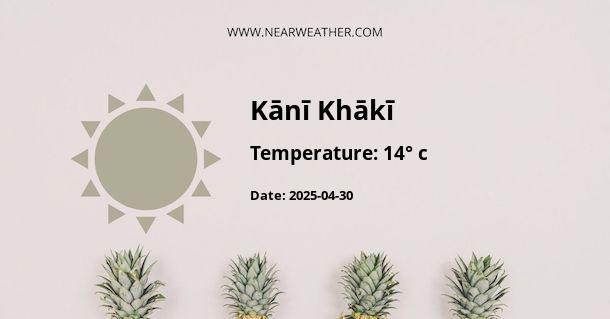Overview
Kānī Khākī, a location nestled in the Sulaymaniyah Governorate of Iraq, is known for its unique climatic conditions. The climate in Kānī Khākī is characterized by a mix of Mediterranean and continental influences. This leads to a fascinating blend of weather patterns, making it an interesting subject of study for meteorologists and climate enthusiasts alike.
Annual Climate and Weather in Kānī Khākī
The climate in Kānī Khākī is primarily semi-arid, falling under the Köppen Climate Classification 'BSk'. This classification signifies a climate where evaporation exceeds precipitation on average but is less than potential evaporation. The weather, as a result, is characterized by hot, dry summers and cold, slightly rainy winters.
Temperature
In Kānī Khākī, the temperatures can vary significantly based on the seasons. The average annual temperature is approximately 16.5°C. The warmest month is July, with an average high temperature of around 35°C, while the coldest month is January, with an average low temperature of approximately 1°C. The temperature can, however, drop below freezing during the winter months.
Precipitation
The region experiences a relatively low annual precipitation level, averaging approximately 400-600 millimeters. Most of the rainfall occurs during the winter months, with December being the wettest month on average. The summer months, on the other hand, are typically quite dry, with little to no rainfall recorded.
Humidity
Humidity levels in Kānī Khākī are generally moderate, with the average annual relative humidity hovering around 60%. The months of December and January usually have the highest relative humidity levels, while the summer months are typically less humid.
Seasonal Weather Patterns
The weather in Kānī Khākī exhibits distinct seasonal patterns.
Spring
Spring in Kānī Khākī usually starts in March and ends in May. The temperatures during this season gradually rise, with average highs ranging from 15°C in March to 28°C in May. The weather is generally mild and pleasant, with moderate rainfall.
Summer
Summer in Kānī Khākī, which extends from June to August, is characterized by hot and dry conditions. The average high temperature during this period can easily exceed 30°C, with July being the hottest month.
Autumn
Autumn in Kānī Khākī, spanning from September to November, brings a gradual decrease in temperatures and an increase in rainfall. The average high temperatures during this period range from 31°C in September to 19°C in November.
Winter
Winter in Kānī Khākī, from December to February, is relatively cold, with average high temperatures ranging from 9°C to 12°C. This period also sees the highest rainfall, with January and February being the wettest months.
Effects of Climate Change
Like many other regions around the world, Kānī Khākī is not immune to the impacts of climate change. Researchers have pointed out that the region is experiencing an increase in average temperatures and a decrease in annual rainfall. This could potentially intensify the aridity of the area, leading to severe implications for agriculture and water availability.
Conclusion
All in all, the climate and weather of Kānī Khākī are marked by significant seasonal variations and a delicate balance between the arid and Mediterranean influences. Understanding these patterns is crucial for planning activities, managing resources, and mitigating the potential impacts of climate change.
A - Kānī Khākī's Latitude is 35.334702 & Longitude is 45.202579.
A - Weather in Kānī Khākī is 14° today.
A - Climate Conditions in Kānī Khākī shows scattered clouds today.
A - Humidity in Kānī Khākī is 64% today.
A - Wind speed in Kānī Khākī is 6.3 km/h, flowing at 95° wind direction. today.
